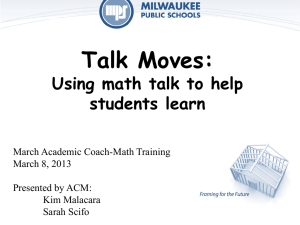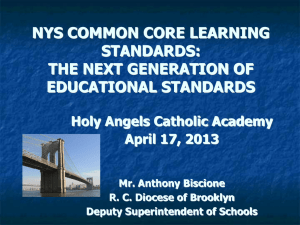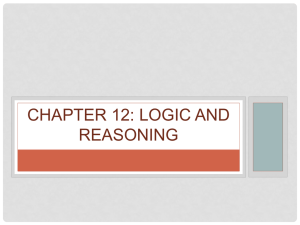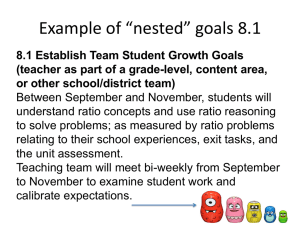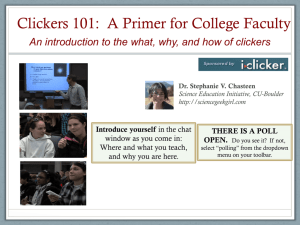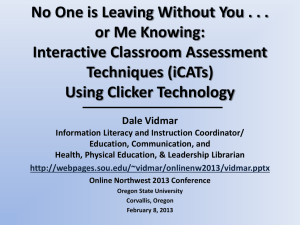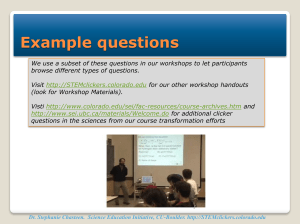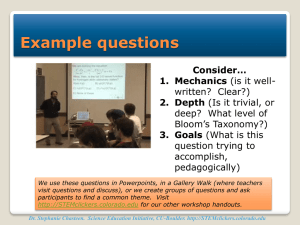Questions to - Inter-disciplinary Program in Educational Technology
advertisement
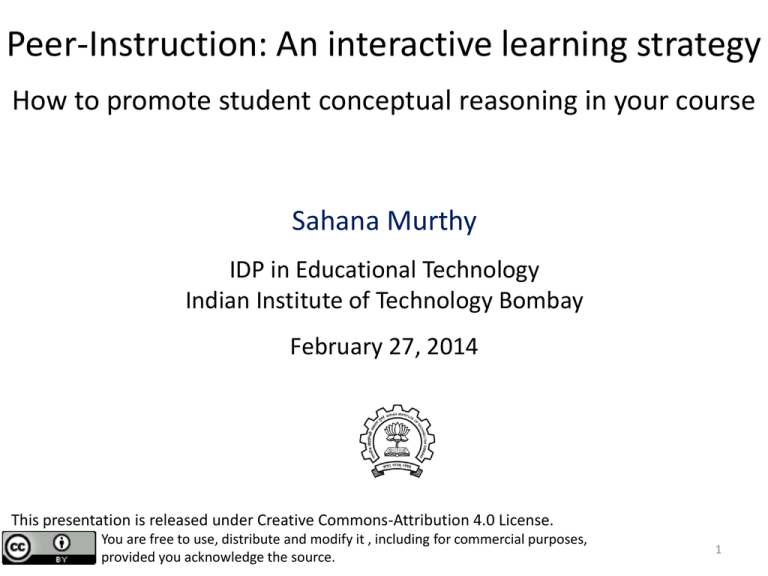
Peer-Instruction: An interactive learning strategy How to promote student conceptual reasoning in your course Sahana Murthy IDP in Educational Technology Indian Institute of Technology Bombay February 27, 2014 This presentation is released under Creative Commons-Attribution 4.0 License. You are free to use, distribute and modify it , including for commercial purposes, provided you acknowledge the source. 1 From Tomorrow’s Professor, Feb 25 2014 Sometimes at the end of a workshop, a participant asks: "If I want to try just one thing you told us about, what should it be?" My answer is always active learning. […] that means engaging students in course-related activities in class other than watching and listening to the instructor. They may be asked to answer a question, begin a problem solution or derivation or figure out the next step, explain a concept, interpret an observation, brainstorm a list, predict the outcome of an experiment, or any of a hundred other things. Stanford Center for Teaching and Learning 2 A quick word on nomenclature Active learning Interactive learning Interactive engagement Different names used by different communities but all are learner-centric strategies 3 Requirements of active learning strategies • Instructor creates carefully designed activities that require students to talk, write, reflect and express their thinking. • Students go beyond listening, copying of notes, execution of prescribed procedures. • Explicitly based on theories of learning. • Evaluated repeatedly through empirical research. Note: Many informal strategies may have the goal of engaging students, but to be termed as active learning, they need to meet the above requirements. Meltzer, David E., and Ronald K. Thornton. "Resource letter ALIP–1: active-learning instruction in physics." American journal of physics 80.6 (2012): 478-496. 4 But my lectures are plenty interactive! • I often pause to ask students if they understood the material • Students can even interrupt with doubts • I never hesitate to answer their questions • I show them demos and videos …. Aren’t these enough? 5 Lecture quality does not seem to matter EXPERIMENT Group 1Group 2 – Two videos ‘Fluent’ video ‘Disfluent video of same speaks fluently, no notes, speaks haltingly, often sees instructor upright, maintains eyenotes, slouches, poor body contact language MEASUREstudent performance by post-test on topic MENT RESULTS Perceived learning greater Perceived equal to actual than actual learning learning Same actual learning for both groups If it is not quality of lectures, what does lead to better learning? S. K. Carpenter et al. “Appearances can be deceiving: instructor fluency increases perceptions6 of learning without increasing actual learning”. Psychonomic bulletin & review,20(6), 1350-1356, 2013. Comparing good lectures with interactive engagement strategies Traditional lecture (14) Interactive engagement strategies (48) Normalized gain <g> = (post-pre)/(100-pre) 90% PI courses • 6542 students • 62 courses – Physics (many instructors with high evals) • Variety of institutions: high school, college, university • Standardized test used – Force Concept Inventory Harvard R. Hake, “Interactiveengagement versus traditional methods: A six-thousand student survey of mechanics test data for introductory physics courses” Amer. Jour. Phy., 66 (1998) 7 Desirable to incorporate interactive engagement strategies How can we achieve active learning? • Think-Pair-Share [Frank Lyman, University of Maryland, early 1980s] (IDP-ET mini-workshop Dec 2013, Sridhar Iyer) • Peer-Instruction [Eric Mazur, Harvard University, early 1990s] • Team-Pair-Solo [Spencer Kagan, University of California, early 2000s] • Many others: – Problem-based learning, Productive failure, Role-play, Jigsaw, 8 What exactly is Peer-Instruction? How is it different from other types of questioning? How is Peer-Instruction related to clickers? Sample question – vote individually A A B Battery Switch open BEFORE B C Battery C Switch closed AFTER What happens to brightness of bulb A after the switch S is closed? 1) Brightness of A decreases 2) Brightness of A increases 3) Brightness of A stays the same 4) I am not sure how to answer this Discuss with your neighbour, vote again A A B Battery Switch open BEFORE B C Battery Switch closed AFTER What happens to brightness of bulb A after the switch is closed? 1) Brightness of A decreases 2) Brightness of A increases 3) Brightness of A stays the same 4) I am not sure how to answer this C Another sample Peer-Instruction Question What is the relationship between the vectors r1 , r2 and R in the figure? r1 R r2 1) R r1 r2 2) R r1 r2 3) R r2 r1 When did I ask this question? The first class after mid-sem (Electricity & Magnetism course) before I gave back student answers. Mid-sem question, result and action QUESTION: Use Biot-Savart law to calculate the magnetic field due to a long wire carrying current I, as a function of distance from the wire. RESULT: Students did not do well on the question. (Answer should be a formula with distance from wire as a parameter). ACTION: 1) Identified main places where students went wrong: Setting up of integral Vectors (r minus r-prime) Problem in vector addition of infinitesimal magnetic fields Many had nonsensical final answers – needed limiting case checks 2) Created a series of conceptual multiple-choice questions aimed to elicit above common difficulties. The questions required verbal and diagrammatical reasoning. 3) Did Peer-Instruction with these questions while discussing midsem. Discussion phase in PI helped students resolve these difficulties. (see the PI Qs used, on next 3 slides) Peer-Instruction Q1 In the figure, with “dl” shown, which pink vector best represents used in Biot Savart’s law? P B A D C dl Origin ˆ dl R I0 I B (r ) E) None of these is close! 2 4 R Question based on Concept Test from University of Colorado Upper Division Electrostatics course Peer-Instruction Q2 To find the magnetic field B at P due to a current-carrying wire we use the Biot-Savart law, 0 dl Rˆ B(r ) I 2 4 R What is the direction of the infinitesimal contribution dB at point P created by current in dl? A) Up the page B) Directly away from dl to left (on the plane of the page) C) Into the page D) Out of the page Question based on Concept Test from University of Colorado Upper Division Electrostatics course P Origin dl I Peer-Instruction Q3 P Which of the following expressions makes sense for the magnetic field B at P due to a current-carrying wire? r Origin dl 0 I 1) 2 r 2) 0 I 2 3) 0 I 2 r I Dissecting Peer-Instruction method What did students (you in the previous slide) do? Talk, argue, listen (sometimes), reason, draw => Actively engaged Learn from each other, teach each other (teach<=>learn) Those who don’t know willing to think, reason, answer Those who do know also participate Pre-existing thinking is elicited, confronted, resolved (How many of you changed your answer?) What are other benefits? To instructor? To class atmosphere Immediate feedback to instructor Students realize that even others are struggling Builds a friendly, yet scientific atmosphere Improve communication Anatomy of Peer-Instruction method Ask Question …Lecture… Debrief / Class Discussion (May vote individually) Peer Discussion Vote Figure attributed to: Stephanie Chasteen and the Science Education Initiative at the University of Colorado 19 See also: Peer Instruction, A User’s Manual. Eric Mazur. Peer-Instruction with clickers But clickers are not Peer-Instruction MIT TEAL classroom From blog.peerinstruction.net Peer-Instruction without clickers – 1 Image from Monash University Peer Instruction in the Humanities Project http://tinyurl.com/kh7uo2o OR: A4 sheet of paper Fold it in four Marker – A, B, C, D Peer-Instruction without clickers - 2 Research on Peer-Instruction PI one of the most widely researched* strategies (* This is good because …) • Extent of research – 300+ research articles – Physics, biology, chemistry maths, CS, engineering, psychology, medicine & nursing … – Many controlled studies using standardized tests • Courses using peer instruction outperform traditional lecture courses on a common test • Students can better answer a question on their own, after peer instruction discussion, (especially difficult questions) – study with 16 pairs of isomorphic questions Smith et al, Science 2009 • Research on student perception says: clickers help students show up for class, feel part of class community, make their voice heard, hold them accountable … From ‘iClickerJan292014’ ppt, Stephanie Chasteen / Science Education Initiative/ CU-Boulder . Activity: Write your own Peer-Instruction question, based on a mid-sem question • Consider a mid-sem question in your course. • Identify what points the students might find difficult in answering it (if you have already graded this, you know exactly what) • Choose one such difficulty / error. • Write a PI question to help address the above difficulty / error. Some possible questions: – Ask students to reason conceptually (increase / decrease, greater / less, left / right, what would happen if … ) – If different representations are part of the problem, create a question based on the representation (translate words to diagram, equation to graph … ) – Give a few possible choices and ask students to argue plausibility of answers using dimensional analysis, limiting cases Writing effective Peer-Instruction questions Group Brainstorm: What are features of a “good” multiple-choice question? • DISCUSS •DISCUSS What makes a good peer-instruction question? An effective peer-instruction question: • Is usually conceptual (avoid long analytic computation) • Elicits pre-existing thinking, students’ alternate conceptions • Has believable distractors • Asks students to predict results of experiment, or algorithm • Makes students apply ideas in new context • Relates different representations • is not ambiguous • is not leading • is not ‘trivial’ Adapted from Clicker Resource Guide, Science Education Initiative/ CU-Boulder . 29 Types of Peer-Instruction questions Different questions for different goals, pedagogical strategies 1. Conceptual reasoning “one right answer” questions 2. Discussion “no one right answer” questions 3. Predict an outcome (e.g., of experiment, program) 4. Embed reasoning in answers (give choice and its reason) 5. Reason using representations 6. As a stepping stone to problem-solving 7. Recall point from previous lecture 8. Survey questions / personal opinion Facts and Concepts - reason towards the Let’s tryanswer” it! “one right A small acorn over time can grow into a huge oak tree. The tree can weigh many tons. Where does most of the mass come from as the tree grows? A)Minerals in the soil B)Organic matter in the soil C)Gases in the air D)Sunlight A Private Universe; Annenberg Media 27 This is an important fact / concept. Can use this question to start discussion on plant growth, photosynthesis etc. Can repeat the question after instruction. From ‘iClickerJan292014’ ppt, Stephanie Chasteen / Science Education Initiative/ CU-Boulder . Facts and Concepts - reason towards the “one right answer” A parallel plate capacitor is charged to a total charge Q and the battery removed. A dielectric slab is inserted between the plates. What happens to the energy stored in the capacitor? A)Increases B) Decreases C) Stays the same Typical conceptual reasoning question. Discussion - “no single right answer” • • • • • • • • A block m sits on a rough inclined surface, attached with a spring (extended) to a fixed point at the other end. As the block moves up the incline a small distance, how many forces are exerted on the block? One force Two forces Good question to get students Three forces to model a physical system Four forces Five forces More than five forces Impossible to determine None of the above From ‘Example Questions’ ppt, Stephanie Chasteen / Science Education Initiative/ CU-Boulder . Original credit Bill Gerace, U. Mass Amherst Activity – write your own question Choose one of the two goals: 1. Conceptual reasoning “one right answer” questions 2. Discussion “no one right answer” questions Write a peer-instruction question for your course. (Make sure you include the choices too ~ 3 to 5) Predict the outcome (of an experiment, video, program) A helium balloon is attached to a string tied to the bottom of a cart on wheels. The sides of the cart are encased in clear plastic. A person will abruptly push the cart to the left. Will the balloon move? A) Yes, to the left B) Yes, to the right C) No Let students vote, then show movie for what happens. http://paer.rutgers.edu/pt3/experiment.php?topicid=13&exptid=121 Get students to predict, show video URL, discuss reasoning in wrap-up Beyond Yes / No: Embed reasoning in answers For which of these Gaussian surfaces will Gauss’ law help us to calculate E at point A (top center) due to the infinite sheet of charge? A) Only the sphere since it is the only one with full symmetry B) Only the cylinder because it has circular symmetry and side walls have zero flux C) Only the cylinder and the cube because they have side walls perpendicular to the sheet and end caps parallel to the sheet D) Only the sphere and cylinder because they have circular cross section E) All surfaces will work because they are all symmetric Question based on Concept Test from University of Colorado Upper Division Electrostatics course Activity – write your own question Choose one of the two goals: 3. Predict an outcome (e.g., of experiment, program) 4. Embed reasoning in answers (give choice and its reason) Write a peer-instruction question for your course. Reasoning with representations Which circuit will satisfy given input output relationship? Diagrammatic representations in question AND choices As a stepping stone to problem-solving A very large (effectively infinite) capacitor has charge Q. A neutral dielectric is inserted into the gap (and of course, it will polarize) . Your goal is to find D everywhere. You can use the following relations: i) D 0 E P ii) iii) D da Q E da Q / +Q free 0 -Q Which equation would you use first? A) The one with P B) The one with Qfree Such questions are useful to start the C) The one with Q/ 0 problem solving process, before students D) I can use any of them first begin to flex their mathematical muscles. Activity – write your own question Choose one of the two goals: 5. Reason using representations (for ex interpret graph) or translate between representations (for ex convert between graph / equation / words / diagram) 6. Conceptual question as a stepping stone to solve a problem Write a peer-instruction question for your course. Recall point from previous lecture Positive ions flow right through a liquid, negative ions flow left. Is there a net current through the liquid? (Same density and speed of both ions) A) Yes, to the right B) Yes, to the left C) No D) Not enough information given I used this in the class after the definition of current was introduced Question based on Concept Test from University of Colorado Upper Division Electrostatics course Survey questions I would like to know a little about you. Choose the most appropriate response. Are you familiar with vector calculus? A) I only know basic differentiation and integration B) I have heard the terms gradient, divergence, curl, but I do not know how to calculate them C) I can calculate gradient, divergence, curl of functions but I do not know how to draw the functions D) I can calculate vector derivatives as well as comfortably draw the functions I used this in the first class in PH103 E&M Survey questions Are you concerned about global climate change? A) Yes B) No C) I don’t think the climate is changing D) I don’t know if the climate is changing Use such questions to begin open discussions on topics where varied opinions exist Personal opinion The pace of this class is: A) Too fast B) Too slow C) Just about right Useful as a mid-semester feedback every 4 weeks or so The quiz was: A) Easy B) Somewhat challenging, but I could do it C) Too challenging Used right after Quiz 1 Summary: question types 1. Conceptual reasoning “one right answer” questions 2. Discussion “no one right answer” questions 3. Predict an outcome (e.g., of experiment, program) 4. Embed reasoning in answers (give choice and its reason) 5. Reason using representations 6. As a stepping stone to problem-solving 7. Recall point from previous lecture 8. Survey questions / personal opinion Activity – write your own question Write a survey / personal opinion question as a peerinstruction question for your course. When to use Peer-instruction questions Questions within the learning cycle BEFORE DURING AFTER Setting up instruction (beginning of module) Developing knowledge (middle of module) Assessing learning (end of module) Questions to: Motivate Discover Provoke thinking Assess prior knowledge Questions to: Check knowledge Application Analysis Evaluation Synthesis Elicit misconception Questions to Relate to big picture Demonstrate success Review or recap Exit poll Adapted from From from “iClicker” by Stephanie 51 Chasteen and the Science Education Initiative at the University of Colorado Challenges and Best Practices What are some challenges you might face • Your concerns? Challenges you might face REPORTED CHALLENGES RECOMMENDED STRATEGIES The class is too quiet. Be patient – students’ reluctance to discuss improves after 3-4 iterations Do solo vote, allow enough time The class is too noisy. That’s ok, this is good noise. Most students are seen to be on task. Explain why you are doing this, use challenging & interesting questions, … let them be Some students just may not participate. Students may not know how to This is not quite true provided reason. questions are designed well The class will get chaotic. How do I get students back? Use a cue such as a bell Best Practices On Writing Questions • Recommended – questions requiring conceptual reasoning (verbal, logical, diagrammatic) • Avoid – questions involving number crunching (but can use PI to precede a numerical problem, for ex … ) • Recommend – Mix it up. – WHY: different pedagogical goals : bringing out a misconception, predicting an outcome, recall point from last class – WHAT: different types of questions: survey, representations, reasoning, Y/N – WHEN: at a variety of points during class (beginning / middle / end) • Avoid - questions that can be answered by memorization (unless that’s your goal, then use sparingly). Best Practices On Facilitating Peer-Instruction • DON’T SKIP ON PEER DISCUSSION (if single vote, only after group talk) • FOCUS ON REASONING NOT ON RIGHT ANSWER. – Withhold judgment. Do not give ‘rapid rewards’ (nodding in assent) – Discuss reasons for right and wrong answers – Ask multiple students to give answers. • TIME. Recommended 2-5 minutes per question. • FREQUENCY. Recommended – a “few” per class, 2-4. (Some instructors for ex Eric Mazur entirely use PI, no lectures). • CREDIT. Do not assign heavy credit for right / wrong answers. Some instructors (with clickers) assign a “whiff” of credit for participation. • I like to circulate, listen to student reasoning, give individual attention Important good practice – Applicable for all active learning strategies GET STUDENT BUY-IN. Create it by explaining why you are doing this. Better still demonstrate why you are doing this. Plenty of resources • Peer-instruction How-tos, workshop slides, videos, research … Carl Wieman Science Education Institute http://www.cwsei.ubc.ca/resources/clickers.htm and host of links from within • Instructors in many disciplines have posted peer-instruction questions for their courses – physics, CS, Statistics – use Google (search with varied nomenclature – PI, clickers, PRS) BUT … • We need to create a library of questions for our courses, report experiences in our context. Please participate!

